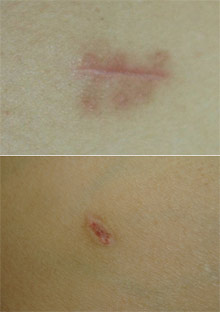A procedure that can help all operated patients look better after surgery. This follows a study by Prof. Avraham Katzir from Tel Aviv University* medics on the battlefield will be able to close open cuts quickly - and save many lives

A group of scientists led by Prof. Avraham Katzir from the applied physics group at Tel Aviv University succeeded in a unique clinical experiment - the first of its kind in the world - to fuse cuts in the human body by heating the cut with a laser - instead of with wire and needle. The new method is much faster than suturing, easy to use and results in fusion of cuts with a minimum of scars.
Following the success of the experiment, the researchers will now try to use the revolutionary system for soldering internal organs in the human body, including arteries, capillaries, and more.
This system is also expected to have many uses in all fields of medicine, both in civilian and military uses. Medics on the battlefield will be able to close open cuts quickly - and save many lives.
"The method of sewing the human body with thread and needle is an old method that has existed in the world for thousands of years," says Prof. Katzir. "Modern medicine has progressed in many areas. The time has come to improve one of the most common and important treatments in surgery - fusion of incisions. Suturing cuts sometimes requires great skill, creates scars and there is a fear of contamination of the wound. Using more advanced methods such as staples or quick glues sometimes create large and ugly scars that remain on the body for years and cause great distress. The new method should solve all these problems. "
The basis of this method was already described in the seventies; Doctors have found that if the edges of an incision are pressed together and heated with a laser beam, it is possible to get a fusion of the incision. The disadvantage of this method, called "laser welding," is that the method is unreliable, it causes burns that interfere with the proper healing of the wound, and it even encourages scarring. Prof. Katzir's group used a different method, called "laser welding", which is based on the fact that a substance used as a biological glue is applied to the surface of the attached cut edges. If this material is heated with a laser beam, the glue hardens and provides mechanical strength as well as a good seal, which prevents the entry of infections and enables rapid healing of the wound. This method has also not been approved for widespread medical use in the world. Prof. Katzir's group worked hard on the development of special optical fibers, which exist only in a few laboratories in the world. These fibers made it possible to develop a unique laser system with which it is possible to "moisten" tissues, while controlling temperature - something that prevents the formation of overheating and burns. In initial experiments, the researchers used a special albumin protein produced by the Israeli biotechnology company Omrix as a biological glue. This system (made entirely by "Blue and White") made it possible to overcome the obstacles described above and led to obtaining excellent preclinical results - something that many researchers around the world were unable to do for about forty years. Therefore, the new method is a major breakthrough in the surgical field.
Following the success of the pre-clinical trials and after the entire system was carefully tested by the Ministry of Health, approval was given by the Ministry of Health to conduct a clinical trial on ten patients. A few months ago, the clinical trial was carried out by a team led by Dr. Doron Kopelman, head of the general surgery department at the "Haemek" medical center in Afula. The laser welding was performed by the doctor Dr. David Simhon, who was a partner in the research that was carried out at Tel Aviv University. Now, after several months of testing and monitoring the patients, it can be concluded that the experiment was a great success. In the experiments it turned out that soldering with the help of a laser caused a good fusion of the cuts. After these clinical trials, Prof. Katzir and his colleagues intend to test the welding method with the help of a laser in longer incisions, such as incisions after inguinal hernia surgery or after cesarean section.
Prof. Katzir predicts that laser welding will be a much simpler surgical operation than sewing with threads. He believes that the simplicity of the method will allow medical personnel who are not doctors, such as medics on the battlefield and nurses in the operating room, to use this method in the future. He also estimates that this method could be used to fuse cuts inside the human body with the help of the special optical fibers mentioned above, in a relatively simple process.
Hundreds of websites are already reporting on this breakthrough, Including the MIT website - One of the most important research institutes in the technological world:
Tens of thousands of surgeries are performed worldwide every day, most of which require stitches. When the use of this system is approved, it will save time in hospitals, streamline and reduce many surgeries, and allow patients a shorter recovery time, with much less complications, pain or scars.

6 תגובות
Very familiar to me...
Really well done, maybe in the distant future everyone will have a small device like this at home near the Polydin.
Well done that an Israeli university invented something that the whole world will enjoy.
SCIENCE and FICTION mix, RESPECT!
impressive.
This would make the word "war" ambiguous for the medics
All the best, be strong and embrace, good luck.
I wish great success for the important project.
Greetings friends,
Ami Bachar